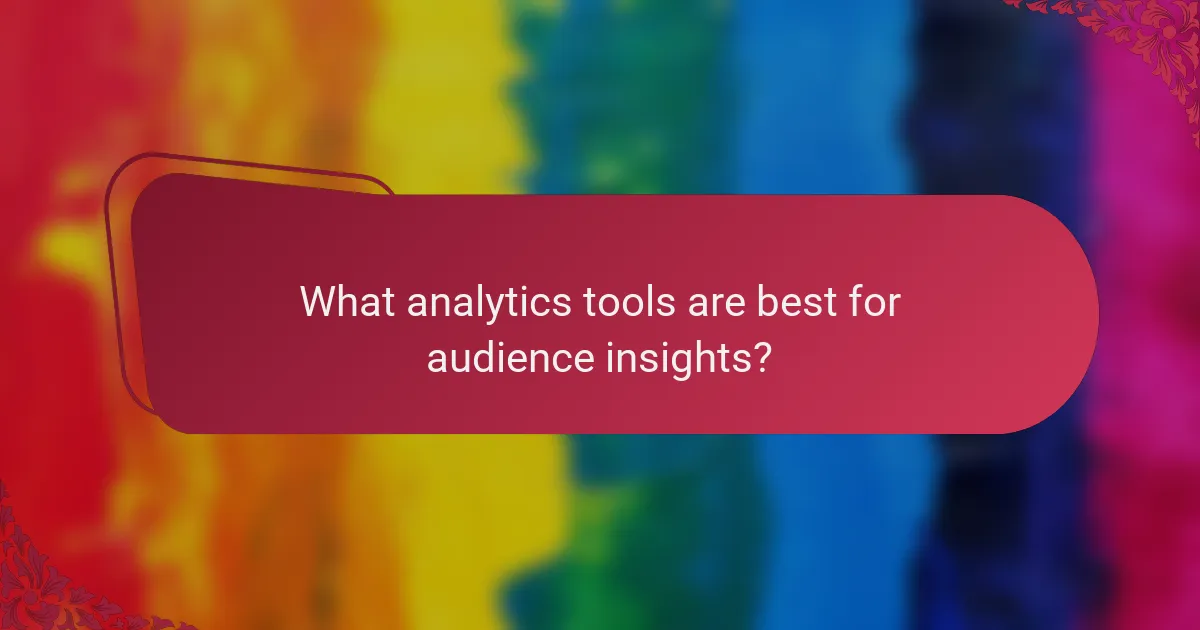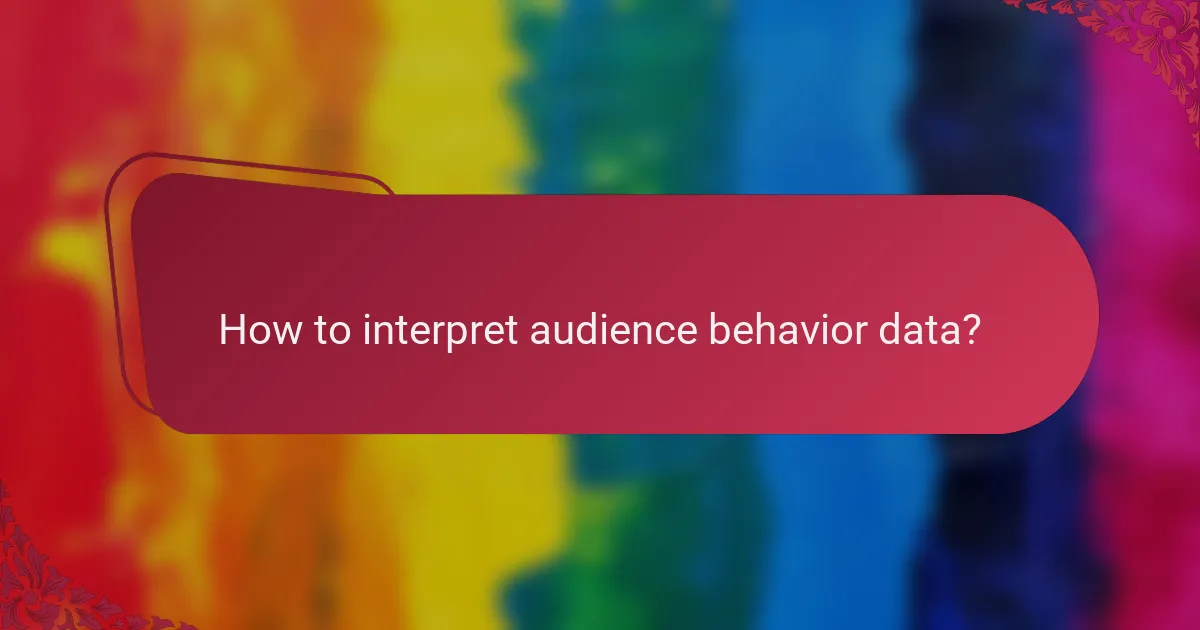Understanding audience insights is crucial for optimizing display advertising performance, as it offers a data-driven perspective on consumer behavior and preferences. By leveraging various analytics tools, advertisers can tailor their strategies to enhance engagement and effectiveness. In 2023, the landscape is evolving with technological advancements and privacy considerations, making real-time data analysis more important than ever.

How can audience insights improve display advertising performance?
Audience insights enhance display advertising performance by providing data-driven understanding of consumer behavior, preferences, and demographics. This information allows advertisers to tailor their strategies, leading to more effective campaigns and higher engagement rates.
Enhanced targeting strategies
Utilizing audience insights enables advertisers to refine their targeting strategies significantly. By analyzing data such as user demographics, interests, and online behavior, marketers can create highly specific audience segments. This targeted approach increases the likelihood of reaching potential customers who are more inclined to engage with the ads.
For example, a clothing retailer might use insights to target ads specifically to young adults interested in fashion trends, rather than a broad audience. This precision can lead to improved click-through rates and conversions.
Increased ROI through data-driven decisions
Data-driven decisions based on audience insights can lead to a notable increase in return on investment (ROI) for display advertising campaigns. By understanding which audience segments respond best to specific ads, advertisers can allocate their budgets more effectively, focusing on high-performing areas.
For instance, if analytics reveal that ads targeting a particular age group yield a higher conversion rate, marketers can shift more resources to that demographic. This strategic allocation can enhance overall campaign performance and maximize ROI.
Personalized ad experiences
Personalization is key to creating engaging ad experiences that resonate with consumers. Audience insights allow advertisers to customize ad content, messaging, and delivery methods based on individual preferences and behaviors. This tailored approach can significantly enhance user engagement.
For example, using insights, a travel agency could present personalized vacation packages based on a user’s previous searches or interests. This not only improves the relevance of the ads but also increases the chances of conversion, as consumers are more likely to respond to content that feels tailored to them.

What analytics tools are best for audience insights?
Several analytics tools can provide valuable audience insights, each with unique features tailored to different platforms. The best choice depends on your specific needs, such as web traffic analysis, social media engagement, or comprehensive reporting.
Google Analytics for web traffic analysis
Google Analytics is a leading tool for analyzing web traffic, offering insights into user behavior, demographics, and acquisition channels. It allows you to track metrics like page views, session duration, and bounce rates, helping you understand how visitors interact with your site.
To make the most of Google Analytics, set up goals to measure conversions and use segments to analyze specific user groups. Regularly review your reports to identify trends and areas for improvement, such as optimizing high-traffic pages or reducing bounce rates.
Facebook Insights for social media engagement
Facebook Insights provides detailed analytics on how users engage with your content on the platform. It tracks metrics such as likes, shares, comments, and overall reach, helping you gauge the effectiveness of your posts and campaigns.
Utilize Facebook Insights to identify your most engaging content and the demographics of your audience. This information can guide your content strategy, allowing you to tailor posts to better resonate with your followers and increase engagement.
Adobe Analytics for comprehensive reporting
Adobe Analytics offers advanced features for comprehensive reporting and data analysis across multiple channels. It provides real-time insights and allows for deep dives into customer journeys, enabling businesses to understand user interactions across various touchpoints.
When using Adobe Analytics, leverage its segmentation capabilities to analyze specific audience groups and their behaviors. Consider integrating it with other Adobe products for a more holistic view of your marketing efforts, ensuring you capture all relevant data for informed decision-making.

What trends are shaping audience insights in 2023?
In 2023, audience insights are increasingly influenced by advancements in technology, particularly AI, as well as heightened privacy concerns and the demand for real-time data. These trends are reshaping how organizations analyze and respond to audience behavior.
Rise of AI-driven analytics
The rise of AI-driven analytics is transforming audience insights by enabling more sophisticated data analysis and predictive modeling. AI tools can process vast amounts of data quickly, identifying patterns and trends that human analysts might miss.
For example, businesses can leverage AI to segment audiences based on behavior and preferences, allowing for targeted marketing strategies. Companies using AI analytics often see improved engagement rates, as campaigns can be tailored to specific audience segments.
Increased focus on privacy regulations
With growing concerns over data privacy, regulations like the GDPR in Europe and CCPA in California are influencing how organizations collect and manage audience data. Companies must ensure compliance to avoid hefty fines and maintain consumer trust.
To navigate these regulations, businesses should implement transparent data collection practices and prioritize user consent. Regular audits of data handling processes can help ensure compliance and build confidence among users regarding their data privacy.
Shift towards real-time data processing
The shift towards real-time data processing allows organizations to respond to audience behavior as it happens. This immediacy can enhance decision-making and improve customer experiences by providing timely and relevant content.
For instance, brands can use real-time analytics to adjust marketing campaigns on the fly based on audience reactions. Implementing tools that support real-time data processing can lead to more agile marketing strategies and better audience engagement.

What performance metrics should be tracked?
Tracking performance metrics is essential for understanding how well your marketing efforts are resonating with your audience. Key metrics such as click-through rates, conversion rates, and customer acquisition costs provide insights into user engagement and the effectiveness of your campaigns.
Click-through rates (CTR)
Click-through rate (CTR) measures the percentage of users who click on a specific link compared to the total number of users who view a page, email, or advertisement. A higher CTR indicates that your content is compelling and relevant to your audience.
To calculate CTR, divide the number of clicks by the number of impressions and multiply by 100. For example, if your ad received 100 clicks from 1,000 impressions, your CTR would be 10%. Aim for a CTR in the low to mid single digits for most online ads, but benchmarks can vary by industry.
Common pitfalls include focusing solely on CTR without considering conversion rates. A high CTR can be misleading if it does not lead to meaningful actions, so always analyze CTR alongside other metrics.
Conversion rates
Conversion rate refers to the percentage of users who complete a desired action, such as making a purchase or signing up for a newsletter. This metric is crucial for assessing the effectiveness of your marketing strategies in driving actual results.
To calculate conversion rates, divide the number of conversions by the total number of visitors and multiply by 100. For instance, if 50 out of 1,000 visitors made a purchase, your conversion rate would be 5%. A good conversion rate typically ranges from 1% to 5%, depending on the industry and type of action.
Ensure that your landing pages are optimized for conversions by using clear calls to action and minimizing distractions. Regularly A/B test different elements to improve your conversion rates over time.
Customer acquisition cost (CAC)
Customer acquisition cost (CAC) is the total cost of acquiring a new customer, including marketing expenses, sales team costs, and any other related expenditures. Understanding CAC helps businesses evaluate the efficiency of their marketing strategies.
To calculate CAC, divide the total costs associated with acquiring customers by the number of new customers gained in a specific period. For example, if you spent $1,000 on marketing and acquired 10 new customers, your CAC would be $100. Aim to keep CAC lower than the lifetime value of a customer to ensure profitability.
Be cautious of overspending on customer acquisition without tracking the return on investment. Regularly review and adjust your marketing strategies to optimize CAC and improve overall business sustainability.

How to interpret audience behavior data?
Interpreting audience behavior data involves analyzing how users interact with content to gain insights into their preferences and actions. This data helps identify trends, measure engagement, and inform strategies for improving user experience and content effectiveness.
Segmentation analysis
Segmentation analysis divides your audience into distinct groups based on shared characteristics, such as demographics, interests, or behaviors. This allows for targeted marketing strategies and personalized content delivery, enhancing engagement and conversion rates.
For effective segmentation, consider factors like age, location, and purchasing habits. Tools like Google Analytics can help identify these segments, enabling you to tailor your approach for each group.
Behavioral trends over time
Analyzing behavioral trends over time reveals how audience interactions change, helping to identify patterns and shifts in preferences. Tracking metrics such as page views, session duration, and bounce rates over weeks or months can highlight significant changes in user engagement.
Utilize time-series analysis to visualize these trends, making it easier to spot seasonal fluctuations or the impact of specific campaigns. Regularly reviewing this data can inform adjustments to content strategies and marketing efforts.
Impact of external factors on engagement
External factors, such as economic conditions, social media trends, or global events, can significantly influence audience engagement. Understanding these influences helps in adapting strategies to maintain or boost user interest during varying circumstances.
For instance, during economic downturns, consumers may prioritize essential content over luxury items. Monitoring news and social trends can provide context for sudden changes in audience behavior, allowing for timely content adjustments.

What are the prerequisites for effective audience analysis?
Effective audience analysis requires a solid foundation of data collection, understanding of target demographics, and integration of various data sources. These elements ensure that insights drawn from analytics are accurate, actionable, and relevant to your specific audience.
Data collection methods
Choosing the right data collection methods is crucial for effective audience analysis. Common techniques include surveys, web analytics, social media monitoring, and customer feedback forms. Each method has its strengths; for instance, surveys can provide direct insights while web analytics offer behavioral data.
Consider combining qualitative and quantitative approaches to gain a holistic view. For example, use surveys to gather opinions and web analytics to track user behavior. Aim to collect data regularly to keep insights current and relevant.
Understanding target demographics
Understanding your target demographics involves analyzing characteristics such as age, gender, location, and interests. This information helps tailor your content and marketing strategies to resonate with your audience. Use tools like Google Analytics or social media insights to gather demographic data.
Segment your audience based on these demographics to create targeted campaigns. For example, a brand targeting millennials might focus on platforms like Instagram, while a product aimed at older adults may find more success on Facebook. Regularly update your demographic profiles to adapt to changing trends.
Integration of multiple data sources
Integrating multiple data sources enhances the depth of your audience analysis. By combining data from web analytics, CRM systems, and social media, you can create a comprehensive view of your audience’s behavior and preferences. This integration allows for more informed decision-making.
Utilize data visualization tools to help synthesize information from different sources. For instance, a dashboard that combines sales data with website traffic can reveal correlations that inform marketing strategies. Ensure that the data is regularly updated and cleansed to maintain accuracy.


